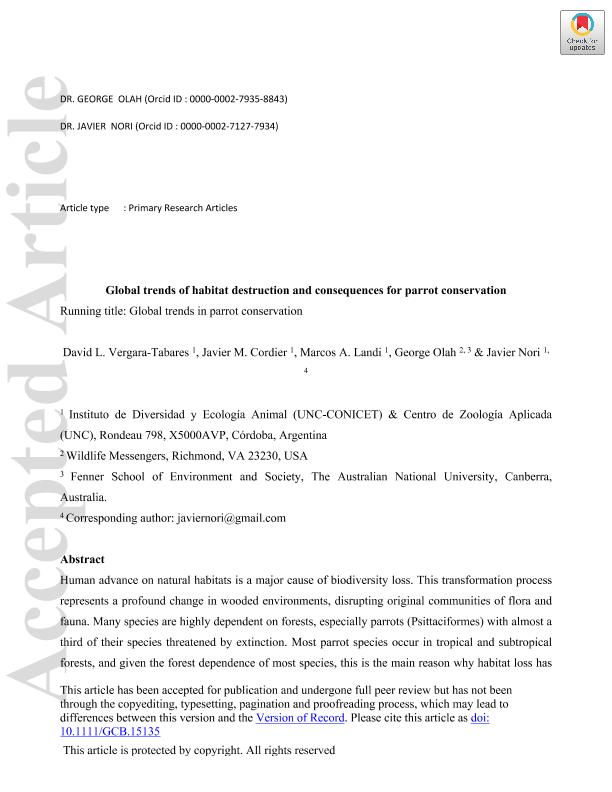Mostrar el registro sencillo del ítem
dc.contributor.author
Vergara Tabares, David Lautaro

dc.contributor.author
Cordier, Javier Maximiliano

dc.contributor.author
Landi, Marcos Alejandro

dc.contributor.author
Olah, George

dc.contributor.author
Nori, Javier

dc.date.available
2021-09-17T12:44:43Z
dc.date.issued
2020-08-27
dc.identifier.citation
Vergara Tabares, David Lautaro; Cordier, Javier Maximiliano; Landi, Marcos Alejandro; Olah, George; Nori, Javier; Global trends of habitat destruction and consequences for parrot conservation; Wiley Blackwell Publishing, Inc; Global Change Biology; 26; 8; 27-8-2020; 4251-4262
dc.identifier.issn
1354-1013
dc.identifier.uri
http://hdl.handle.net/11336/140645
dc.description.abstract
Human advance on natural habitats is a major cause of biodiversity loss. This transformation process represents a profound change in wooded environments, disrupting original communities of flora and fauna. Many species are highly dependent on forests, especially parrots (Psittaciformes) with almost a third of their species threatened by extinction. Most parrot species occur in tropical and subtropical forests, and given the forest dependence of most species, this is the main reason why habitat loss has been highlighted as the main threat for the group. Such habitat loss acts in synergy with other important threats (e.g., logging and poaching), which become especially problematic in certain developing countries along tropical latitudes. In this study, we used available information on parrot distributions, species traits, IUCN assessment, habitat loss and timber extraction for different periods, and distribution of protected areas, to determine conservation hotspots for the group, and analyze potential changes in the conservation status of these species. We detected four conservation hotspots for parrots: two in the Neotropics and two in Oceania, all of them facing different degrees of threat in regard of current habitat loss and agricultural trends. Our results suggest that the future of the group is subject to policymaking in specific regions, especially in the northeastern Andes and the Atlantic Forest. In addition, we predicted that agricultural expansion will have a further negative effect on the conservation status of parrots, pushing many parrot species to the edge of extinction in the near future. Our results have conservation implications by recommending protected areas in specific parrot conservation hotspots. Our recommendations to mitigate conservation risks to this group of umbrella species would also benefit many other coexisting species as well.
dc.format
application/pdf
dc.language.iso
eng
dc.publisher
Wiley Blackwell Publishing, Inc

dc.rights
info:eu-repo/semantics/openAccess
dc.rights.uri
https://creativecommons.org/licenses/by-nc-nd/2.5/ar/
dc.subject
ANTHROPOGENIC THREAT
dc.subject
DEFORESTATION
dc.subject
IUCN
dc.subject
PROTECTED AREAS
dc.subject
PSITTACIFORMES
dc.subject
TEMPORAL ANALYSIS
dc.subject
TIMBER EXTRACTION
dc.subject.classification
Conservación de la Biodiversidad

dc.subject.classification
Ciencias Biológicas

dc.subject.classification
CIENCIAS NATURALES Y EXACTAS

dc.title
Global trends of habitat destruction and consequences for parrot conservation
dc.type
info:eu-repo/semantics/article
dc.type
info:ar-repo/semantics/artículo
dc.type
info:eu-repo/semantics/publishedVersion
dc.date.updated
2021-09-06T15:46:53Z
dc.journal.volume
26
dc.journal.number
8
dc.journal.pagination
4251-4262
dc.journal.pais
Reino Unido

dc.journal.ciudad
Londres
dc.description.fil
Fil: Vergara Tabares, David Lautaro. Consejo Nacional de Investigaciones Científicas y Técnicas. Centro Científico Tecnológico Conicet - Córdoba. Instituto de Diversidad y Ecología Animal. Universidad Nacional de Córdoba. Facultad de Ciencias Exactas Físicas y Naturales. Instituto de Diversidad y Ecología Animal; Argentina. Universidad Nacional de Córdoba. Facultad de Ciencias Exactas Físicas y Naturales. Centro de Zoología Aplicada; Argentina
dc.description.fil
Fil: Cordier, Javier Maximiliano. Consejo Nacional de Investigaciones Científicas y Técnicas. Centro Científico Tecnológico Conicet - Córdoba. Instituto de Diversidad y Ecología Animal. Universidad Nacional de Córdoba. Facultad de Ciencias Exactas Físicas y Naturales. Instituto de Diversidad y Ecología Animal; Argentina. Universidad Nacional de Córdoba. Facultad de Ciencias Exactas Físicas y Naturales. Centro de Zoología Aplicada; Argentina
dc.description.fil
Fil: Landi, Marcos Alejandro. Consejo Nacional de Investigaciones Científicas y Técnicas. Centro Científico Tecnológico Conicet - Córdoba. Instituto de Diversidad y Ecología Animal. Universidad Nacional de Córdoba. Facultad de Ciencias Exactas Físicas y Naturales. Instituto de Diversidad y Ecología Animal; Argentina. Universidad Nacional de Córdoba. Facultad de Ciencias Exactas Físicas y Naturales. Centro de Zoología Aplicada; Argentina
dc.description.fil
Fil: Olah, George. Wildlife Messengers; Estados Unidos
dc.description.fil
Fil: Nori, Javier. Consejo Nacional de Investigaciones Científicas y Técnicas. Centro Científico Tecnológico Conicet - Córdoba. Instituto de Diversidad y Ecología Animal. Universidad Nacional de Córdoba. Facultad de Ciencias Exactas Físicas y Naturales. Instituto de Diversidad y Ecología Animal; Argentina. Universidad Nacional de Córdoba. Facultad de Ciencias Exactas Físicas y Naturales. Centro de Zoología Aplicada; Argentina
dc.journal.title
Global Change Biology

dc.relation.alternativeid
info:eu-repo/semantics/altIdentifier/url/https://onlinelibrary.wiley.com/doi/abs/10.1111/gcb.15135
dc.relation.alternativeid
info:eu-repo/semantics/altIdentifier/doi/https://doi.org/10.1111/gcb.15135
Archivos asociados
